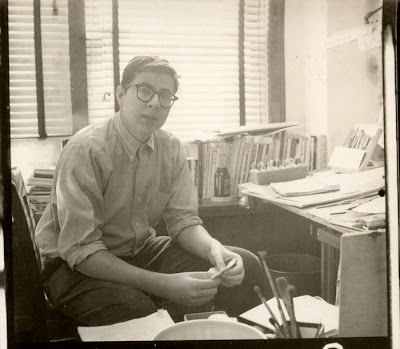Over the past few months I've been corresponding with Ed Fella via email. Back in September I had the pleasure of speaking to him on the phone. We spoke for about an hour and a half discussing design and illustration. Ed told me of his philosophies on the subject and how his work became popular and accepted as influential in the design community. A modest man, he didn't pin point specific reasons why his work has garnered so many accolades and recognition. He spoke of it as being merely a "quirkiness" in the quality of his work. He identified that same "quirky" quality in the work of other professionals he admires, such as illustrator and designer Ron Rae. During our conversation he explained to me how the work that "took off" for him wasn't initially done for paying clients. It was more personal work than not. He agreed to create some brochures for a non profit client if he could incorporate his "personal" typographic style into the piece. The deal was made and the project completed. It was circulated, picked up and featured in a design publication, and the rest, as they say, is history.
Ed Fella is one of the most famous graphic designers of our time and as you can imagine, there is a lot of information covered in a conversation with him. My talk with him was very inspiring and I came away wanting to pursue even more of my own personal work in addition to what I do for paying clients. Ever since we spoke I've been getting back to basics - stretching the boundaries of my imagination and pushing beyond the limitations of my skills.
Below Ed Fella has put together a partial auto biography, philosophy and history lesson. It ends rather abruptly but Ed has promised more for us in the near future. Below he has accompanied his writings with some of his art, which he explained to me, either hasn't been seen before, or has made rare appearances here and there. This is a proud moment for me and Illustration Pages. I hope you enjoy what Ed Fella has put together for us here today.
Introduction by Lou Simeone
Ed Fella - Artist, Designer, Typographer and Educator
Contributed to Illustration Pages by Ed Fella
I worked in Detroit as a commercial artist from 1957 to about 1987, which makes for a good 30 years. We were called "Commercial Artists" in the 50s and 60s even though we did illustration, lettering, typography, and layout (now called graphic design). Somehow the term fell on hard times by the mid 60s and we were reluctant to use it (except to our mothers) and we all eventually became either Graphic Designers or Illustrators. What many of us did could also be called “Design Illustration”, since we frequently combined all the categories in our projects. I think at the time, Push Pin Studios in New York set these practices into the forefront: we all were part of that subset between strictly literal or realistic illustrators and pure graphic designers who combined text with images and occasionally did a logotype. We were also known as "Decorative Illustrators". I like the use of precise terms as it helps define and contextualiz



